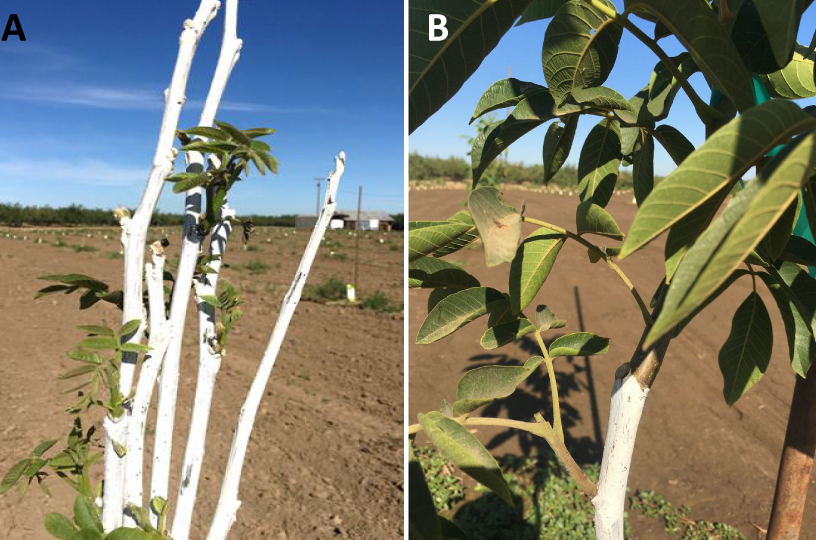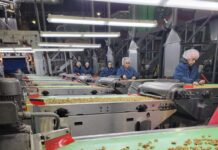Over the last three years, we have received several calls from walnut growers in Sacramento and northern San Joaquin Valleys reporting widespread dieback observed in both young and mature orchards during the spring. In most cases, we suspected autumn freeze to be the major cause of those dieback symptoms. We usually try to differentiate between injury during the growing season, which is referred to as frost injury and the freeze damage that occurs in late fall or winter.
The term frost injury is restricted to damage due to freezing temperatures during the growing season while the tree is not dormant, which is due to a late spring frost. This was not the case for the past three years based on our farm calls and minimum air temperature data (degrees F) collected from CIMIS stations located near affected walnut orchards. Figure 1 shows the minimum air temperature data collected from the CIMIS station located in Manteca, Calif. for November/December 2018, November/December/January/February 2019 and 2020, and January/February 2021.

In mid-November 2018, sudden minimum temperatures were low (ranging from 26.4 degrees F to 29.8 degrees F) in some locations, causing damage in young, vigorous orchards as well as in mature orchards. The damage observed was not as widespread compared to what we are seeing this year, which may be due in some ways to the rains that occurred after the 9- to 10-day freeze event (Figure 2).

Fortunately, we went through winter 2019 with little stress to young/mature walnut orchards, since temperatures were warm enough to protect these trees, and you can notice how much wetter the weather was during the end of November and December 2019 compared to the 2020 November/December time (Figure 1 and 2).
This year, from mid- to late April, we received several calls reporting severe dieback/not leafing out symptoms in large areas of walnut orchards in San Joaquin and Stanislaus counties. Symptoms were observed in newly planted orchards and young, vigorous orchards as well as mature orchards, including Chandler, Howard, Tulare, Serr and Solano cultivars (Figure 3 and 4).

Reasons for Damage Severity
To face the November/early December freeze events, walnut trees must harden by developing processes of resistance to cold and frost. We believe that the acclimation to temperatures below freezing results from exposure to the gradual decline in temperatures, which allow trees to gradually lower the freezing point of their cells in order to not be damaged under the freezing effect. It is a very complex process: once the temperature slowly begins to drop, the trees synthesize enzymes that will break down the starch (large sugar molecules made by photosynthesis and stored in summer in the bark and wood) in smaller soluble sugars with higher anti-freeze activity, which protect against ice formation in tree cells.
This was not the case with the significant temperature fluctuation we faced during November/early December 2020. The first freeze event occurred on November 9 and 10, which followed a period of temperatures ranging from 37 degrees F to 44 degrees F (first eight days of November, at least allowing the trees to harden off a little but not enough.) Then, we noticed that the temperatures rose over the next 10 days (ranging from 30 degrees F to 50 degrees F), then relapsed again below freezing for a few hours early in the morning of the November 21 and 22, and the last four days of the month. Temperatures continued to fluctuate during the first nine days of December 2020 (Figure 1).
These temperature fluctuations pose a serious threat, especially for young, vigorous walnut trees during the winter. Sudden temperature drops place high amounts of stress on trees, the effects of which are much worse when followed by mild and dry weather.
Symptoms Observed
The severity of symptoms is variable across and within orchard blocks. Significant damage can be observed in young, vigorous orchards. Tip dieback occurs with many branches in affected trees still green or partially green (damage beneath the bark appears as brown discoloration) and not leafing out (Figure 5).

Based on our preliminary observation, we noticed that orchards irrigated in late October to early November showed less damage compared to those irrigated early to mid-October. More information should be gathered for the irrigation practices and other practices (prior to the November/December 2020 freeze event) from these severely affected orchards.
We are in the process of developing a survey in collaboration with other farm advisors and PCAs in counties showing severe freeze damage to help identify the factors that have contributed to the freeze damage this year and how we can mitigate their future impact.
Freeze Damage Management
For young, vigorous trees as well as mature trees, the damage in some tree branches/limbs looks dramatic, but the survival of these tree parts depends more on whether they are still green/alive.
Do NOT prune out damaged limbs now. Buds may be slow to break or may fail to completely break, and adventitious buds may emerge from under the bark. Prune out the dead wood that did not revive at the time of pre-harvest or postharvest. Formed new shoots can be trained to replace the damaged wood.
To help prevent further damage from sunburn, exposed larger limbs/branches (southwest facing area) can be painted with tree paint or white latex paint diluted 1:1 with water.
Orchards/blocks severely affected by the freeze will have lower overall growth with an expected yield reduction, which will reduce nitrogen requirements. Much of the nitrogen demand comes from the crop, and hence must be reduced. Make fertilizer decisions based on current soil reports and leaf analysis.
Less leaf surface area results in reduced water loss (less transpiration). Monitor your orchard carefully and schedule irrigation using a pressure chamber and/or soil moisture measuring devices throughout the season. By using the pressure chamber, you directly measure the level of water stress your trees are experiencing because it measures the plant and not the soil. Start your irrigation when pressure chamber readings are two to three bars below baseline.
Newly planted trees showing dieback symptoms due to freeze damage are more vulnerable than older trees. The lack of foliage will provide a prime target for Flathead Borer and more sunburn damage.
With enough healthy shoots left on the tree, cutting below the damaged tissue would help the tree rejuvenate and should not be an issue at this point (Figure 6).
If there are not enough leaves, damaged tissue that was not painted with a white-wash (December/January) after the freeze events should be painted now to protect against further sunburn damage and/or borer.

Prepare and Protect Trees
There are additional steps you can take to prepare for a freeze event.
Trees should enter the fall months as healthy as possible, but growth should be reduced. Cutting back some on irrigation in September and no nitrogen applications after August could help slow down growth and may help the trees harden off before a sudden freeze event comes along.
For young trees, stop irrigating in September to set the terminal bud on the trunk to harden the trees, then resume irrigation to avoid tree stress.
A dry fall could make freeze damage worse. If there is not enough rain by the end of harvest, irrigate walnut orchards so the soil is moist in November.
To keep orchards slightly warmer, it is advisable to run the irrigation system a few days before an expected freeze event to ensure the soil surface is moist and help the soil store a little more heat in advance during sunny days. This will also ensure trees are hydrated enough before the freeze occurs. Moist soil absorbs more solar radiation than dry soil, and will re-emit heat overnight.











